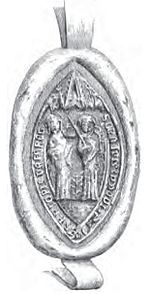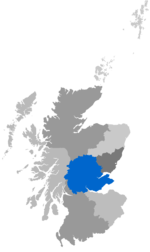Perth (Scottish English: PERTH; Scottish Gaelic: Peairt [pʰɛrˠʃtʲ]) is a centrally located Scottish city, on the banks of the River Tay. It is the administrative centre of Perth and Kinross council area and is the historic county town of Perthshire. It had a population of about 47,430 in 2018.There has been a settlement at Perth since prehistoric times. It is a natural mound raised slightly above the flood plain of the Tay, at a place where the river could be crossed on foot at low tide. The area surrounding the modern city is known to have been occupied ever since Mesolithic hunter-gatherers arrived there more than 8,000 years ago. Nearby Neolithic standing stones and circles date from about 4,000 BC, a period that followed the introduction of farming into the area. Close to Perth is Scone Abbey, which formerly housed the Stone of Scone (also known as the Stone of Destiny), on which the King of Scots were traditionally crowned. This enhanced the early importance of the city, and Perth became known as a "capital" of Scotland due to the frequent residence there of the royal court. Royal burgh status was given to the city by King William the Lion in the early 12th century. The city became one of the richest burghs in the country, engaging in trade with France, the Low Countries, and the Baltic countries, and importing goods such as Spanish silk and French wine.
The Scottish Reformation had a strong impact on the city: the Houses of the Greyfriars and Blackfriars, two of Perth's four monastic institutions at the time of the Reformation, were ransacked after a sermon given by John Knox in St John's Kirk in 1559. The 1701 Act of Settlement brought about Jacobite uprisings. The city was occupied by Jacobite supporters on three occasions: in 1689, 1715 and 1745. The founding of Perth Academy in 1760 helped to bring major industries to the city, including the production of linen, leather, bleach and whisky. Perth was fortuitously placed to become a key transport centre with the coming of the railways, and its first station was built in 1848.
Perth has been known as "The Fair City" since the publication of the novel Fair Maid of Perth by Scottish writer Sir Walter Scott in 1828. During the later medieval period the city was also called St John's Toun or Saint Johnstoun by its inhabitants—a reference to its principal church, which was dedicated to St John the Baptist. This name is preserved in the name of the city's football club, St Johnstone F.C. The city often refers to itself using the promotional nickname "Gateway to the Highlands", a reference to its location. Perth is twinned with Aschaffenburg, in the German state of Bavaria, and there are several places in the world named after Scotland's Perth, including Perth, Western Australia; Perth, Tasmania; Perth, Canada; and Perth Amboy, United States.
Today, Perth serves as a retail centre for the surrounding area, and in 2018 the city was named "Scotland's Food Town of 2018" by the Scottish Food Awards. Following the decline of the local whisky industry, the city diversified its economy, building on its long-established presence in the insurance industry to increase its standing in the banking industry.










